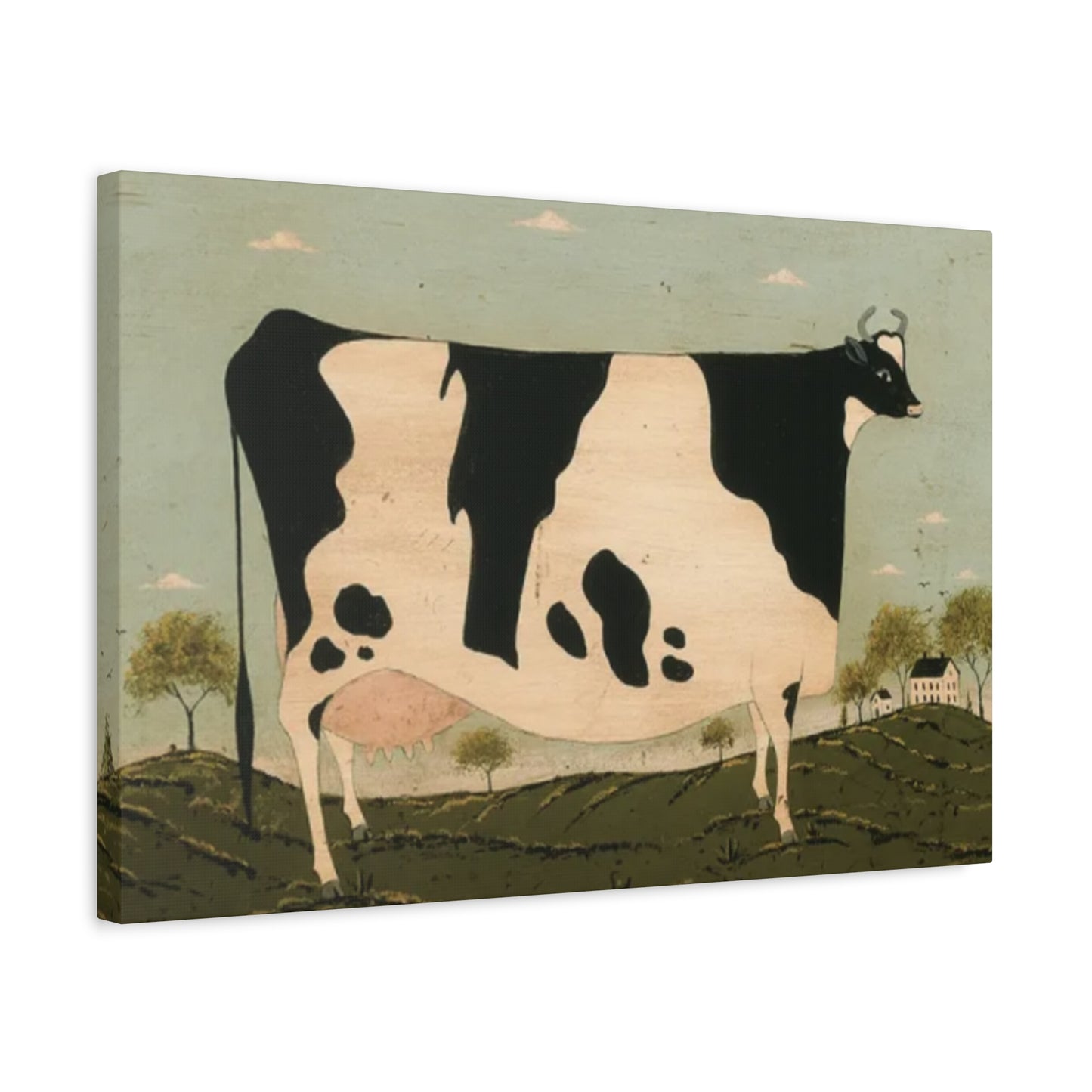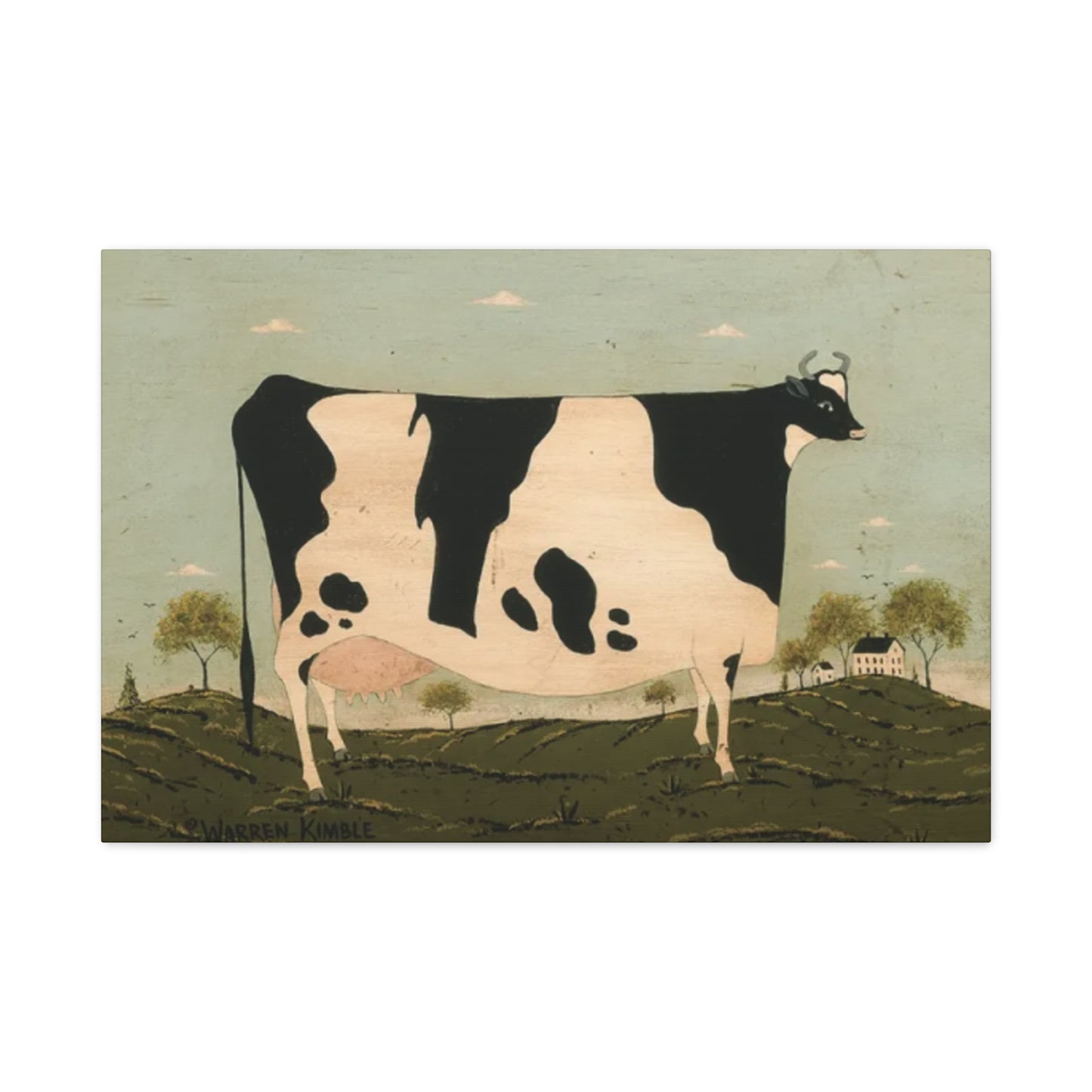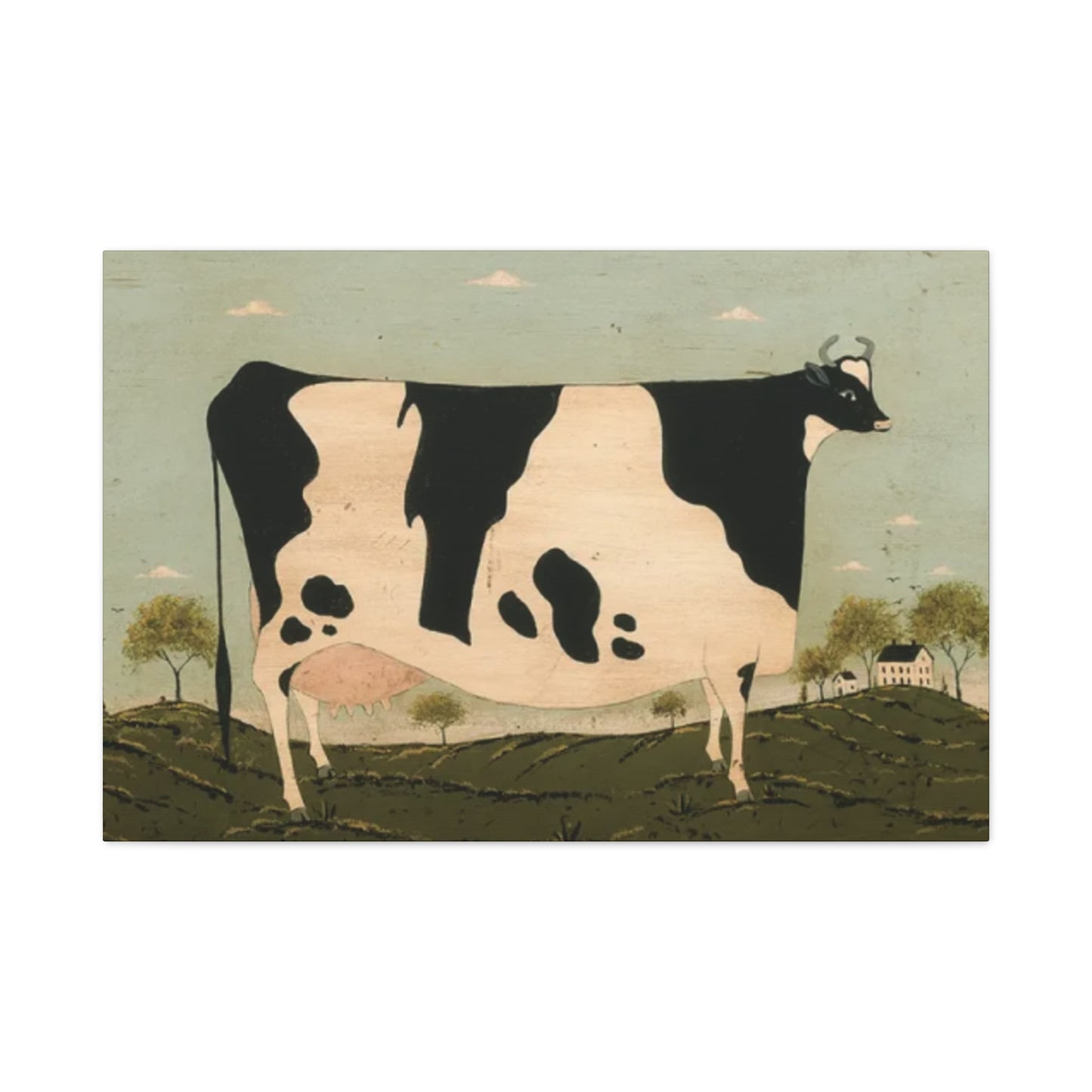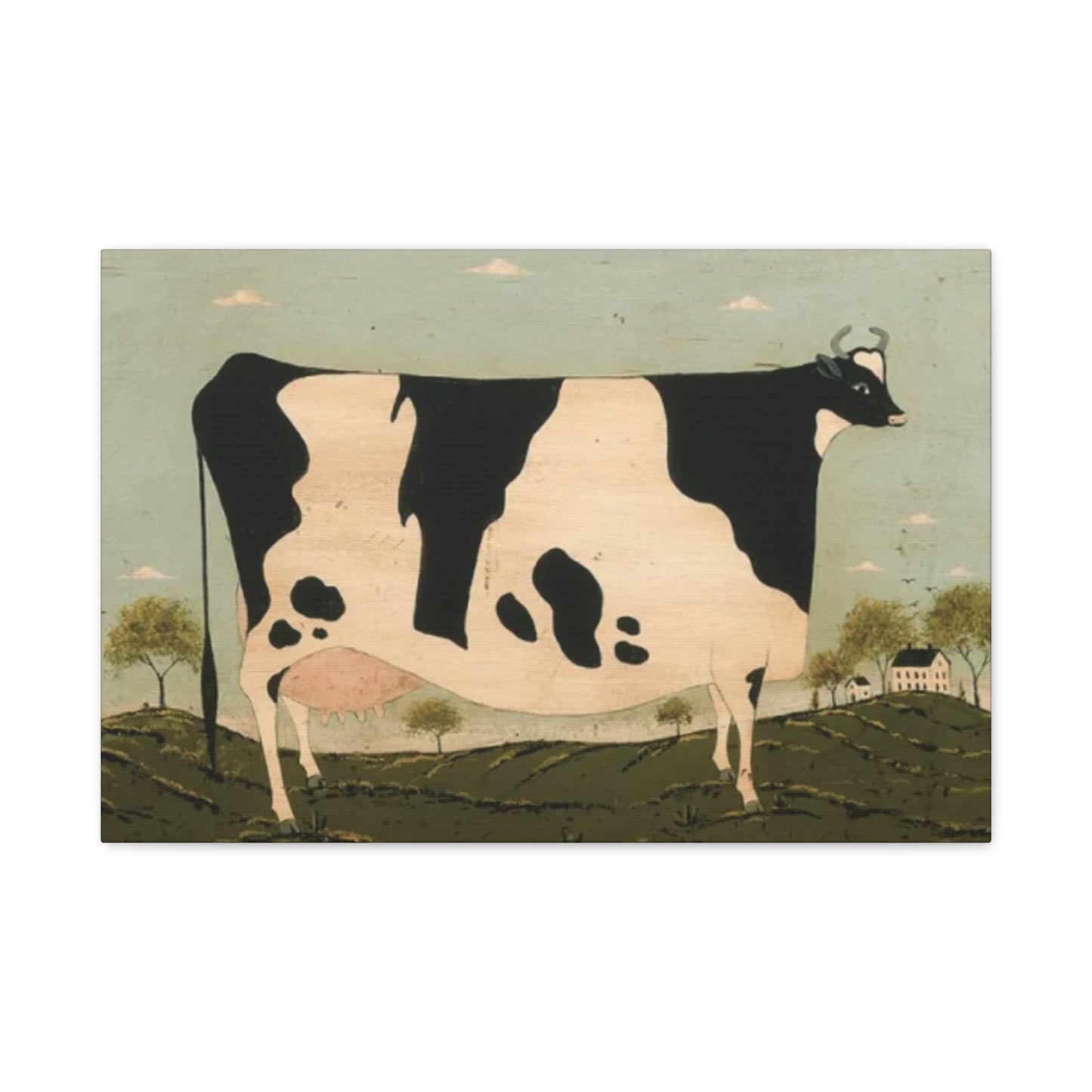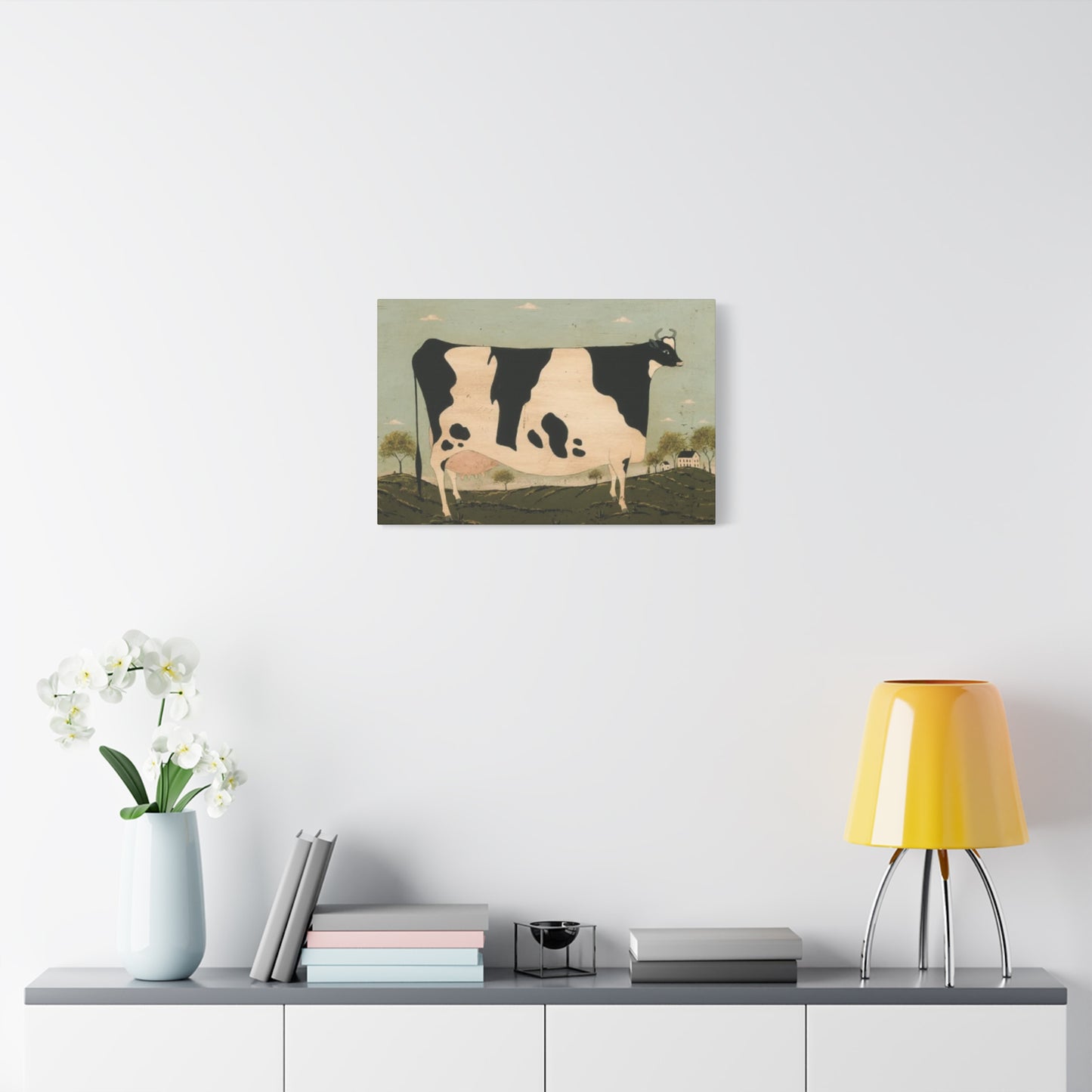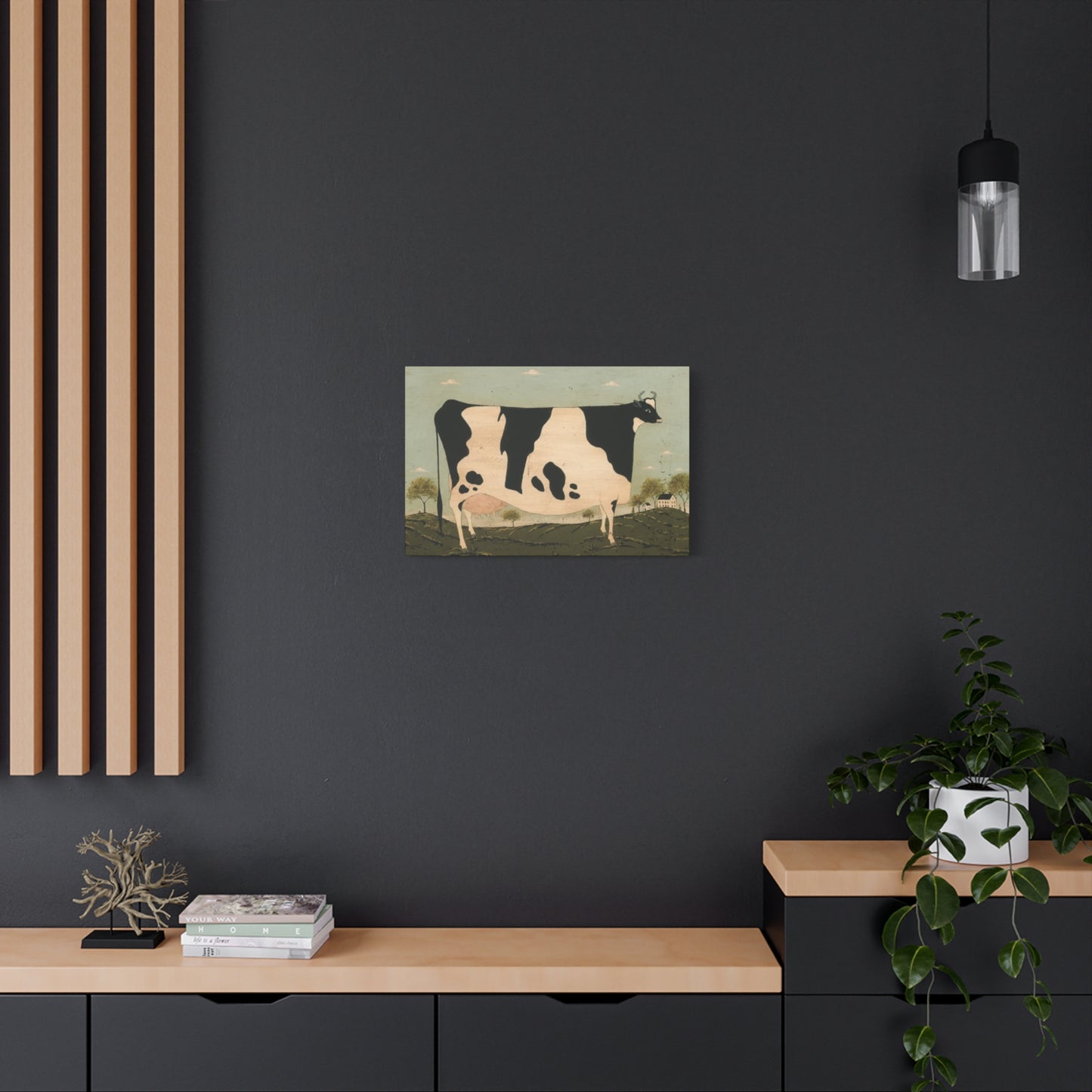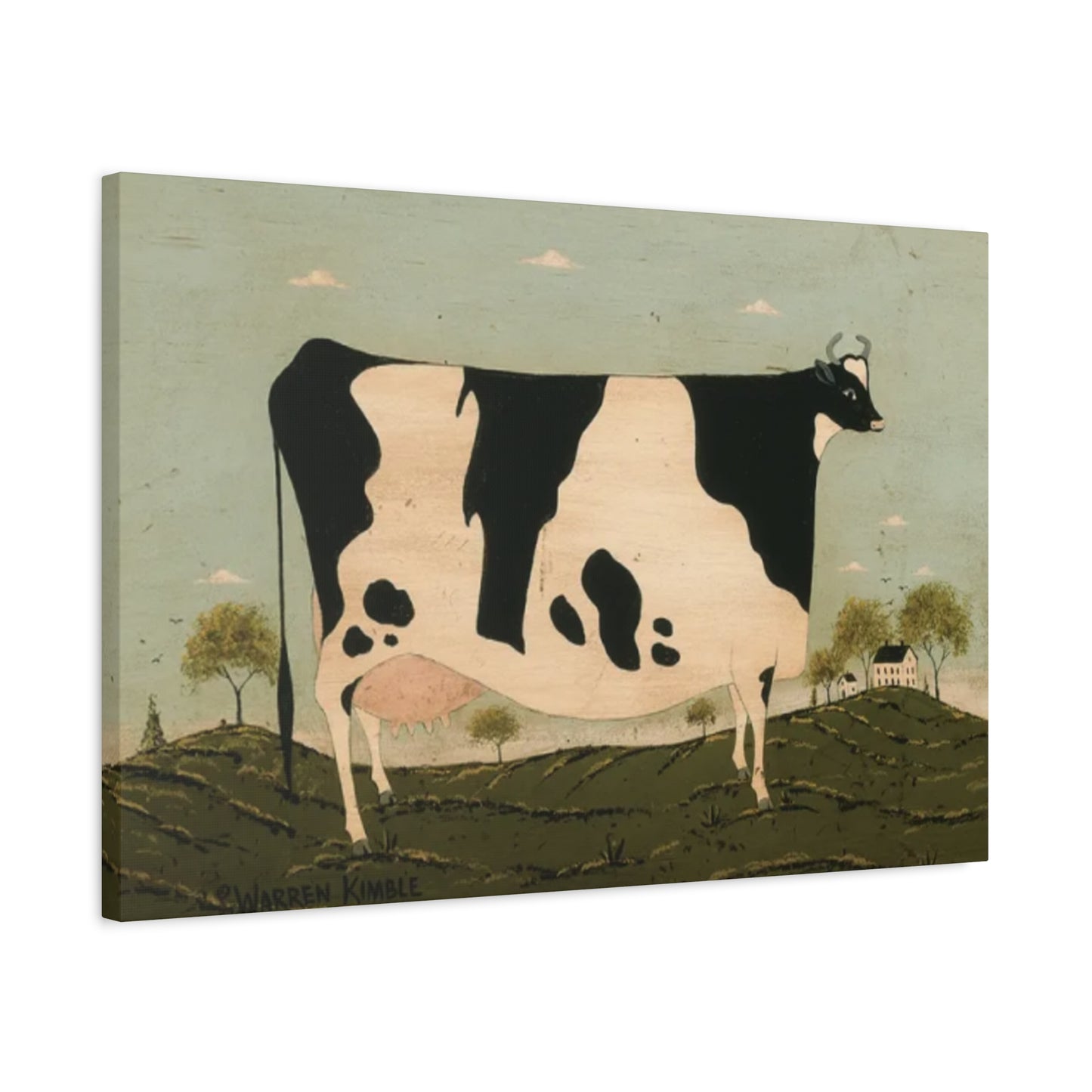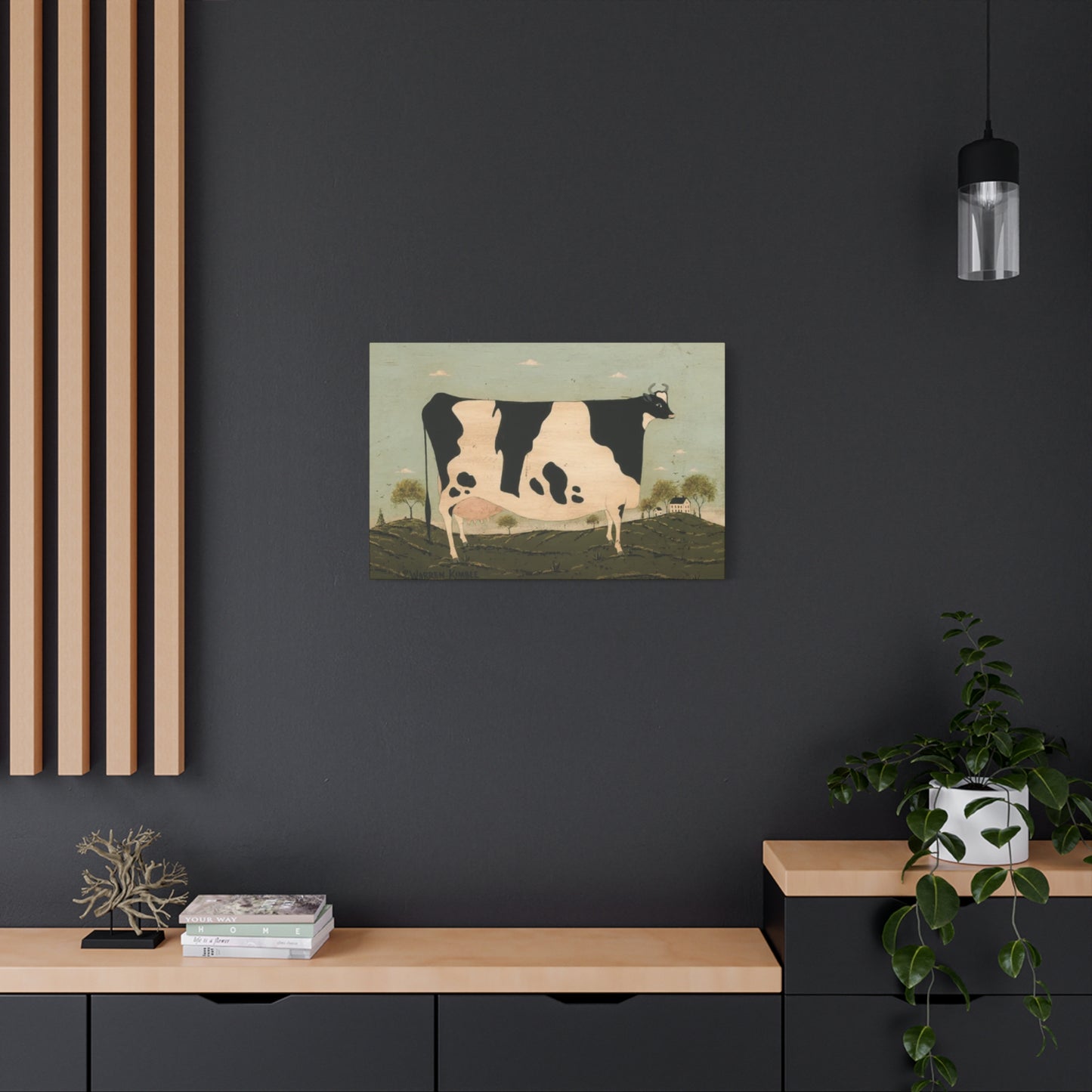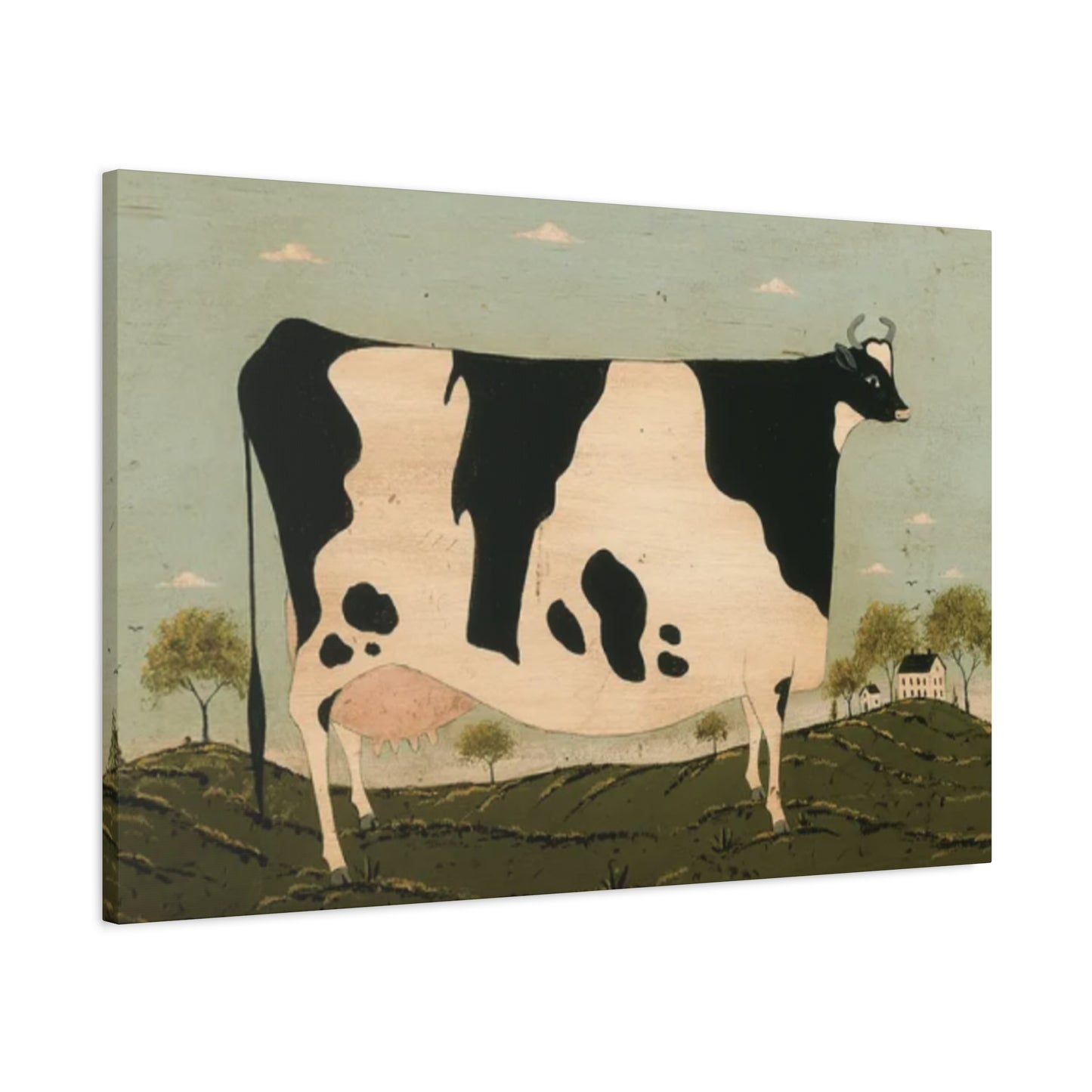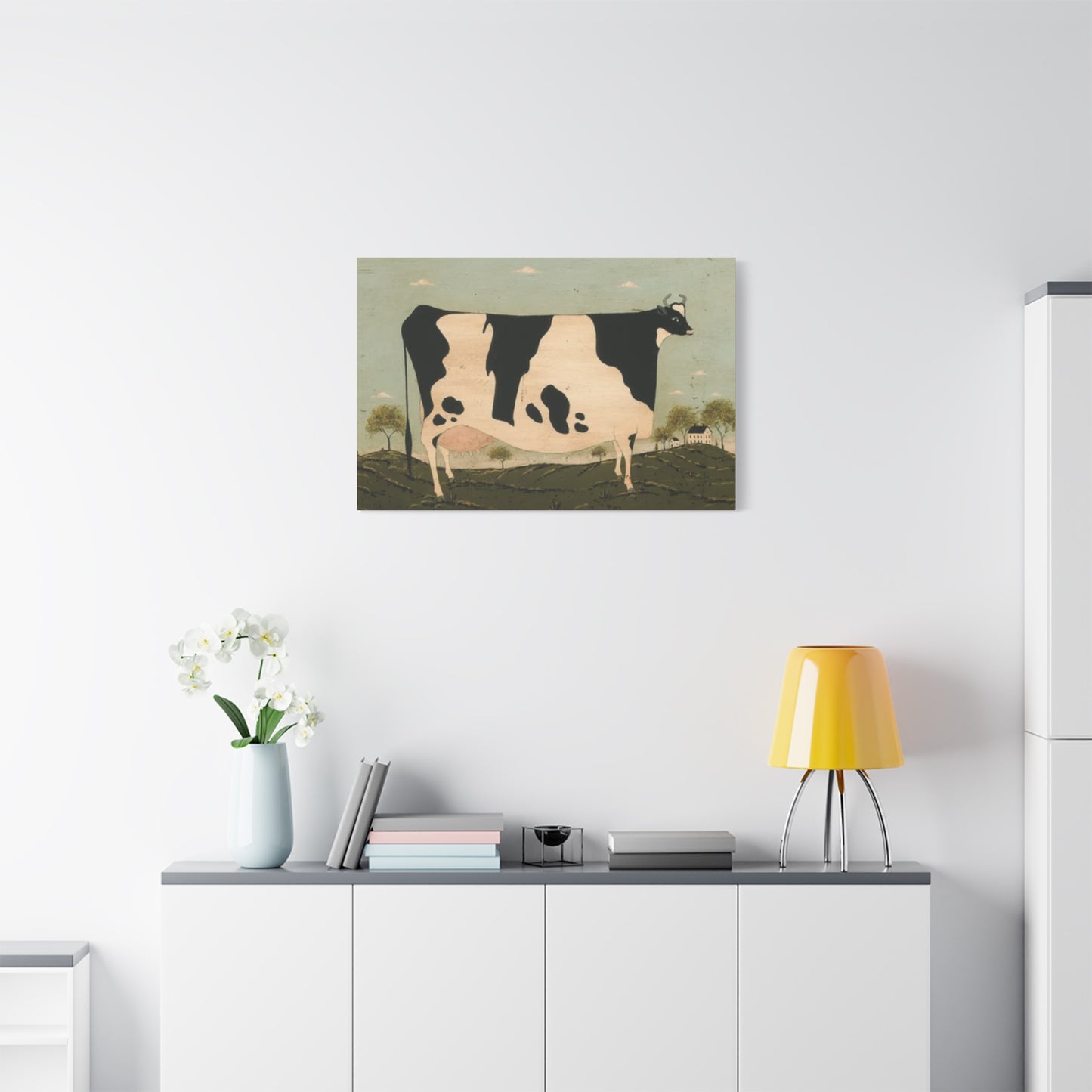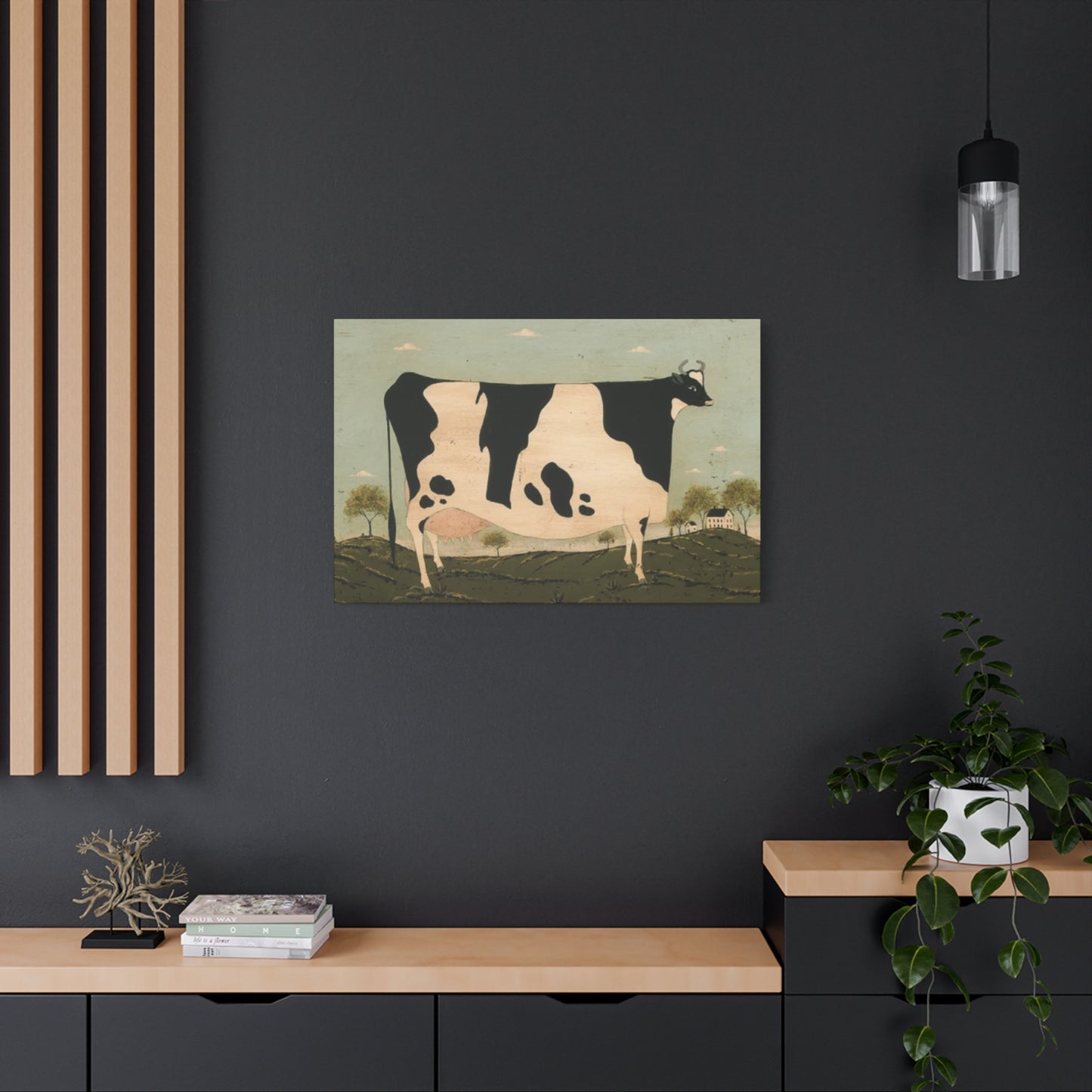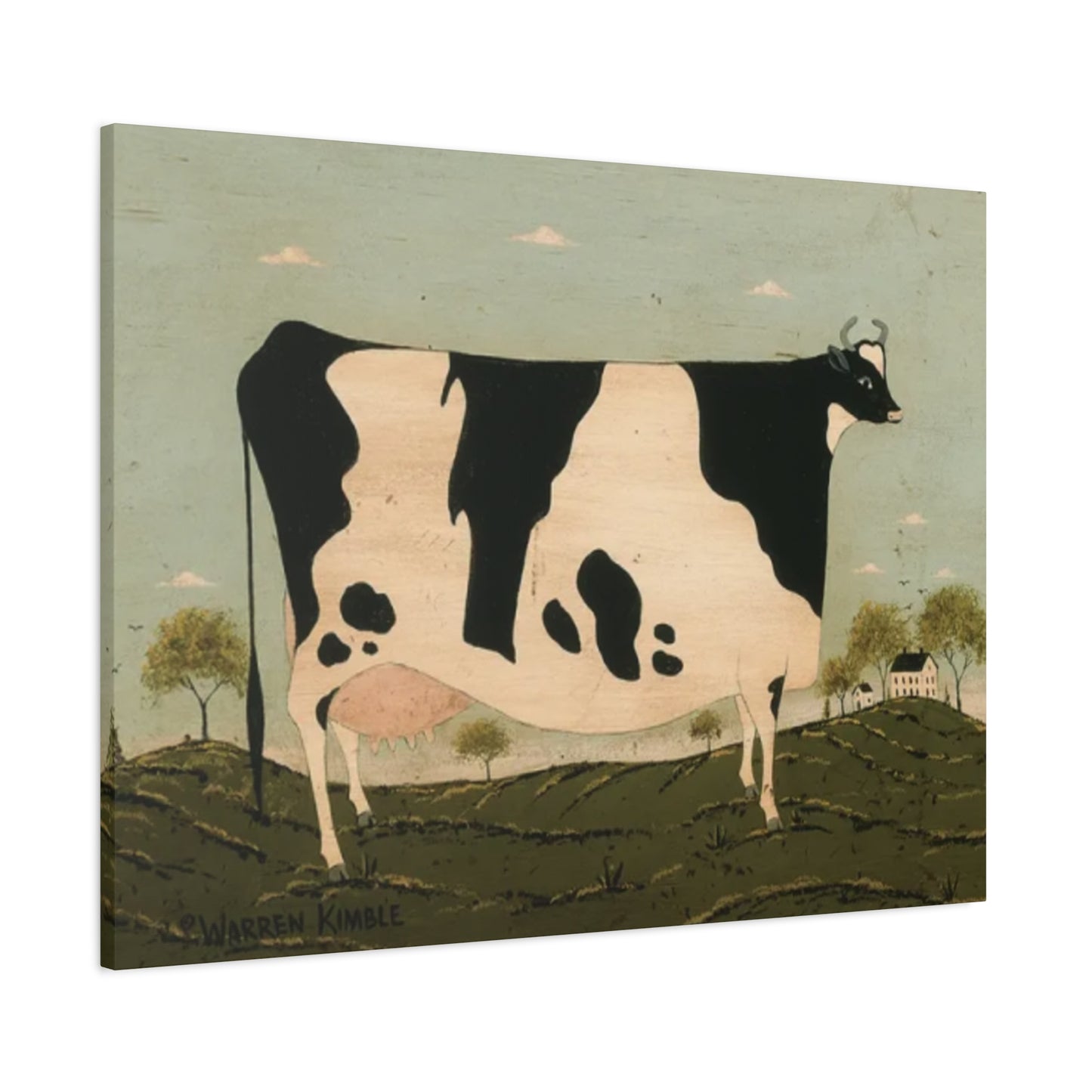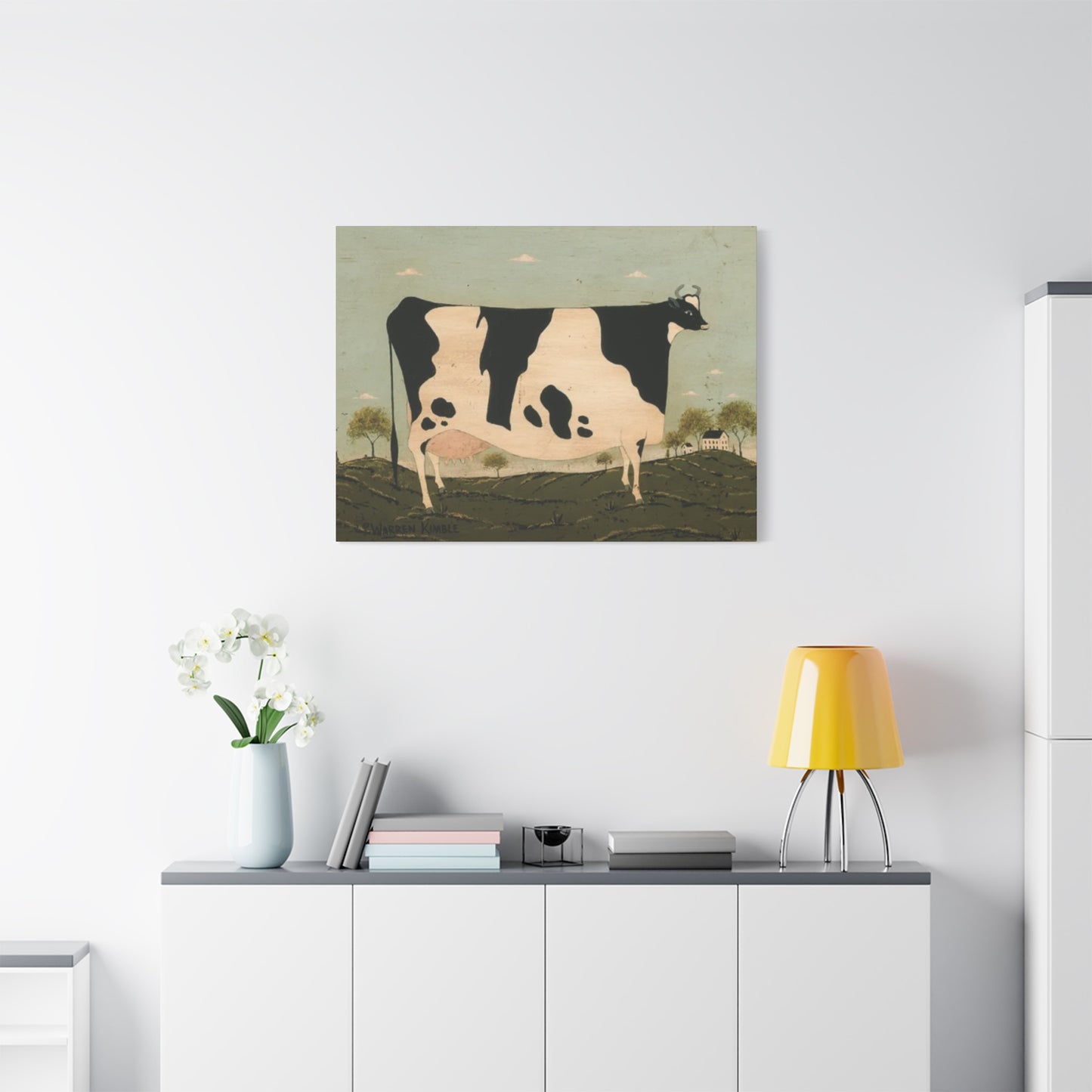Kimble Warren Black and White Cow Wall Art – Canvas Prints for Farmhouse or Rustic Décor
The intersection of rural imagery and sophisticated interior design has created a compelling aesthetic movement that resonates deeply with homeowners seeking authentic connections to simpler times. Kimble Warren's black and white cow artwork represents a pinnacle of this artistic fusion, where pastoral scenes meet refined artistic sensibility. The monochromatic palette of these bovine masterpieces offers versatility that transcends seasonal trends, making them enduring additions to any living space that values both artistic merit and nostalgic charm.
The appeal of agricultural themes in home decoration stems from a fundamental human desire to reconnect with nature and traditional values. Warren's cow paintings capture this sentiment perfectly, presenting familiar farm animals in compositions that celebrate both their natural beauty and their symbolic significance in American culture. The decision to render these subjects in black and white removes any temporal limitations, creating artwork that feels simultaneously contemporary and timeless.
Contemporary homeowners increasingly seek decor that tells a story, and Warren's cow artwork provides rich narrative possibilities. Each piece invites viewers to contemplate rural life, agricultural heritage, and the peaceful coexistence between humans and animals that has defined farming communities for generations. The artistic treatment elevates these everyday subjects to the realm of fine art, making them suitable for sophisticated interior schemes while maintaining their approachable, down-to-earth character.
The popularity of farmhouse-style decorating has created unprecedented demand for authentic agricultural artwork. Warren's cow paintings fulfill this need by offering genuine artistic interpretation rather than commercial reproductions. The artist's attention to detail and understanding of bovine anatomy and behavior lends credibility to these works, ensuring they resonate with viewers who appreciate both artistic skill and subject matter authenticity.
Examining the Visual Language of Monochromatic Bovine Art
The power of black and white imagery lies in its ability to distill subjects to their essential elements, and Warren's cow artwork demonstrates this principle magnificently. By removing color from the equation, these pieces focus attention on form, texture, and composition, creating visual experiences that are both calming and engaging. The monochromatic approach allows viewers to appreciate the subtle gradations of light and shadow that define bovine forms, from the gentle curves of a cow's flank to the distinctive patterns of Holstein markings.
Warren's mastery of tonal variation creates depth and dimensionality that brings these pastoral subjects to life on canvas. The interplay between light and dark areas establishes focal points that guide the viewer's eye through each composition, creating visual journeys that mirror the peaceful meandering associated with rural landscapes. This sophisticated use of contrast demonstrates the artist's understanding of classical artistic principles while maintaining the accessibility that makes these works perfect for residential display.
The artistic choice to render cows in monochrome also speaks to themes of simplicity and authenticity that resonate strongly with contemporary audiences. In a world increasingly dominated by digital imagery and artificial enhancement, these straightforward black and white presentations offer visual respite. They celebrate the inherent beauty of agricultural subjects without relying on flashy effects or unnatural color schemes, creating artwork that feels honest and grounded.
The textural qualities achieved through Warren's monochromatic technique add layers of visual interest that reward close examination. Subtle variations in brushwork and shading create surfaces that seem to invite touch, from the smooth appearance of a cow's hide to the rougher textures suggested by surrounding vegetation. This tactile quality enhances the overall sensory experience of viewing these works, making them more than mere decorative elements.
Agricultural Heritage Through Contemporary Artistic Expression
Warren's cow artwork serves as a bridge between agricultural heritage and contemporary artistic expression, honoring farming traditions while appealing to modern aesthetic sensibilities. These pieces celebrate the dignity of farm life and the noble character of dairy cattle, presenting them as worthy subjects for serious artistic consideration. The respectful treatment of these animals reflects an understanding of their importance in agricultural communities and human civilization more broadly.
The artist's approach to depicting cows reveals deep appreciation for these gentle giants of the farm. Rather than presenting them as merely functional livestock, Warren's paintings portray cows as individuals with distinct personalities and inherent beauty. This perspective aligns with growing awareness of animal sentience and the importance of treating all creatures with respect and admiration. The resulting artwork resonates with viewers who share these values while maintaining broad appeal.
The compositional choices in Warren's cow paintings often emphasize the peaceful nature of bovine behavior, showing these animals in moments of quiet contentment. This portrayal reinforces positive associations with rural life and farming practices, presenting agriculture as a harmonious relationship between humans and animals. Such imagery provides emotional comfort to viewers who may feel disconnected from natural cycles and agricultural processes in their daily lives.
The historical significance of cattle in human development adds layers of meaning to these artistic works. From ancient cave paintings to contemporary gallery exhibitions, bovine subjects have captured human imagination for millennia. Warren's contributions to this artistic tradition honor this legacy while bringing fresh perspective to familiar subjects, ensuring their relevance for contemporary audiences seeking meaningful artistic content.
Design Principles Behind Effective Farmhouse Wall Art Selection
Successful integration of cow artwork into residential spaces requires understanding fundamental design principles that govern visual harmony and aesthetic cohesion. Warren's black and white cow paintings offer exceptional flexibility in this regard, as their monochromatic nature allows them to complement virtually any color scheme while maintaining their distinctive character. The key lies in considering scale, placement, and surrounding design elements to create compositions that enhance rather than overwhelm existing decor.
Scale considerations play a crucial role in determining the impact of cow artwork within living spaces. Large-format Warren pieces command attention and can serve as focal points for entire rooms, while smaller works function effectively as accent pieces that add character without dominating. The artist's attention to compositional balance ensures that pieces work effectively at various sizes, maintaining their visual integrity whether displayed as statement pieces or grouped with other artworks.
Placement decisions significantly influence how cow artwork integrates with existing interior design schemes. Warren's pieces work particularly well in spaces that emphasize natural materials and organic forms, such as rooms featuring exposed wood beams, stone elements, or natural fiber furnishings. The monochromatic nature of these works allows them to serve as visual anchors that tie together disparate design elements while adding cohesive agricultural themes.
The lighting conditions in display spaces affect how black and white cow artwork appears and functions within interior design schemes. Warren's pieces respond beautifully to natural lighting, which enhances the subtle tonal variations and creates dynamic visual experiences that change throughout the day. Artificial lighting should be carefully considered to avoid harsh contrasts that might diminish the sophisticated gradations that characterize these monochromatic works.
Exploring Emotional Connections Through Pastoral Imagery
The psychological impact of agricultural imagery extends far beyond simple decoration, tapping into deep-seated human connections to the natural world and simpler ways of life. Warren's cow artwork facilitates these emotional connections by presenting subjects that evoke feelings of tranquility, stability, and continuity. The gentle nature of cows as depicted in these pieces creates calming effects that can significantly enhance the ambiance of residential spaces.
Research in environmental psychology suggests that exposure to nature imagery, including agricultural subjects, can reduce stress and promote feelings of well-being. Warren's cow paintings contribute to these positive effects by bringing elements of rural life into urban and suburban environments. The peaceful expressions and relaxed postures of the cows in these artworks communicate serenity that viewers unconsciously absorb, creating more restful and harmonious living environments.
The nostalgic qualities inherent in agricultural artwork appeal to fundamental human desires for connection to heritage and tradition. Many viewers find comfort in cow imagery that reminds them of family farms, rural childhoods, or simpler times when life moved at a more manageable pace. Warren's artistic treatment honors these memories while creating new associations that enhance contemporary living experiences.
The meditative qualities of monochromatic imagery provide additional psychological benefits that enhance the appeal of black and white cow artwork. The simplified visual information allows viewers to rest their eyes and minds, creating opportunities for contemplation and reflection. This quality makes Warren's pieces particularly valuable in bedrooms, reading areas, and other spaces designated for relaxation and restoration.
Mastery in Monochromatic Agricultural Art
Warren's technical proficiency in creating compelling black and white cow artwork demonstrates mastery of fundamental artistic principles that elevate these pieces beyond mere decoration. The artist's understanding of light behavior, shadow formation, and tonal relationships creates convincing three-dimensional effects on two-dimensional surfaces. This technical excellence ensures that each piece maintains visual interest and artistic integrity regardless of viewing distance or lighting conditions.
The rendering of bovine anatomy in Warren's works reflects careful study and deep understanding of cow physiology and movement patterns. The artist captures subtle details that bring authenticity to these agricultural subjects, from the particular way light plays across a cow's hide to the characteristic stance and proportions that define different breeds. This attention to anatomical accuracy enhances the credibility of these artistic interpretations while maintaining their aesthetic appeal.
Compositional techniques employed in Warren's cow paintings demonstrate sophisticated understanding of visual design principles. The artist uses elements such as leading lines, rule of thirds placement, and balanced negative space to create harmonious arrangements that please the eye while maintaining dynamic interest. These compositional strategies ensure that each piece works effectively as both individual artwork and part of larger decorative schemes.
The brushwork techniques visible in Warren's cow paintings reveal artistic processes that balance spontaneity with control, creating surfaces that appear both finished and alive with creative energy. The varied application of paint creates textural interest that enhances the monochromatic palette, while careful attention to edge quality defines forms without creating harsh boundaries. This technical approach contributes to the overall sophistication of these agricultural art pieces.
Creating Cohesive Interior Narratives with Agricultural Art
The integration of cow artwork into residential design schemes offers opportunities to develop cohesive interior narratives that celebrate agricultural themes while maintaining contemporary sophistication. Warren's black and white pieces serve as excellent foundation elements for these thematic approaches, providing visual anchors around which complementary design elements can be arranged. The key lies in balancing obvious agricultural references with subtle supporting details that enhance rather than overwhelm the overall aesthetic.
Successful agricultural interior narratives incorporate natural materials that echo the rural environments suggested by cow artwork. Elements such as reclaimed wood, natural stone, and organic textiles create contextual backgrounds that enhance the impact of Warren's paintings while maintaining design sophistication. The monochromatic nature of these artworks allows them to work effectively with various material palettes, from warm woods to cool metals.
Color scheme development around black and white cow artwork offers considerable flexibility while requiring careful consideration of tonal relationships. Neutral palettes provide safe foundations that allow artwork to dominate, while carefully selected accent colors can create more dynamic schemes without competing with the monochromatic focal points. Warren's pieces work particularly well with earth tones, muted blues, and sage greens that reference natural agricultural environments.
Furniture selection for spaces featuring cow artwork should emphasize comfort and functionality while respecting the rural themes suggested by these pieces. Overly formal or ornate furniture styles may conflict with the honest, straightforward character of agricultural art, while pieces that reference traditional craftsmanship and natural materials enhance thematic coherence. The goal is creating environments that feel both sophisticated and approachably comfortable.
Historical Context of Bovine Subjects in Fine Art
The artistic tradition of depicting cattle spans millennia, from prehistoric cave paintings to contemporary gallery exhibitions, positioning Warren's cow artwork within a rich historical continuum. Ancient civilizations recognized cows as symbols of abundance, fertility, and divine favor, themes that continue to resonate in contemporary agricultural art. This historical context adds layers of meaning to modern bovine artwork, connecting contemporary viewers to fundamental human relationships with domestic animals.
European artistic traditions have long celebrated pastoral subjects, with Dutch Golden Age painters particularly renowned for their cattle paintings that combined technical mastery with idealized rural imagery. These historical precedents established aesthetic conventions that continue to influence contemporary agricultural art, including the emphasis on naturalistic rendering and peaceful compositional arrangements that characterize Warren's work.
American artistic traditions have embraced agricultural subjects as expressions of national identity and values, with cow imagery playing prominent roles in celebrations of rural life and farming heritage. This cultural context enhances the appeal of Warren's cow artwork for American audiences who recognize these subjects as symbols of hard work, self-reliance, and connection to the land. The artistic treatment honors these associations while creating fresh interpretations for contemporary viewers.
The evolution of agricultural art reflects changing relationships between humans and farm animals, from purely functional livestock to valued companions and conservation subjects. Warren's respectful portrayal of cows acknowledges this evolution while maintaining appreciation for traditional farming practices and the important role of cattle in human civilization. This balanced perspective ensures broad appeal while respecting diverse viewpoints on agricultural practices.
Material Considerations for Agricultural Art Display
The physical presentation of cow artwork significantly impacts its aesthetic effectiveness and longevity, requiring careful consideration of materials, framing, and display methods. Warren's black and white pieces benefit from framing approaches that enhance their sophisticated character while protecting them from environmental damage. The choice of materials should complement the agricultural themes while maintaining gallery-quality presentation standards.
Framing materials for cow artwork should balance durability with aesthetic appropriateness, considering both the artistic content and the display environment. Natural wood frames often work well with agricultural subjects, providing contextual references while offering practical benefits such as stability and repairability. Metal frames can create more contemporary presentations that emphasize artistic rather than thematic qualities, depending on interior design goals.
Matting decisions for black and white cow artwork affect both presentation quality and conservation outcomes. Acid-free materials prevent degradation while providing visual separation between artwork and framing elements. Mat colors should complement the monochromatic palette without competing for attention, with neutral tones typically providing the most satisfactory results for long-term display.
Glass selection for protecting cow artwork involves balancing visibility with conservation requirements. Museum-quality glazing materials offer superior protection from ultraviolet light while minimizing reflections that might interfere with viewing experiences. The additional cost of premium glazing materials represents worthwhile investments for protecting valuable artwork while ensuring optimal presentation quality.
Seasonal Adaptability of Monochromatic Agricultural Art
One of the primary advantages of black and white cow artwork lies in its ability to adapt to seasonal decorating changes without losing relevance or appeal. Warren's monochromatic pieces serve as constant elements around which seasonal accessories can be arranged, providing stability while allowing for creative expression through complementary decorative elements. This adaptability makes agricultural art particularly valuable for homeowners who enjoy refreshing their interiors throughout the year.
Spring decorating schemes benefit from the fresh, optimistic qualities inherent in cow imagery, which naturally evokes themes of renewal and agricultural awakening. Warren's pieces can be enhanced with seasonal accessories in soft greens and pastels that reference new growth without overwhelming the sophisticated monochromatic palette. The key is maintaining balance between seasonal enthusiasm and artistic integrity.
Summer presentations of cow artwork can emphasize the leisurely, pastoral qualities that make agricultural subjects so appealing during warm weather months. Natural textures and materials work particularly well with Warren's pieces during summer, creating environments that feel connected to outdoor experiences while maintaining interior comfort. Light, airy accessories complement the serene qualities of monochromatic cow paintings.
Autumn provides opportunities to emphasize the harvest themes associated with agricultural life, making cow artwork particularly relevant during this season of agricultural celebration. Warm earth tones and natural materials create rich contextual backgrounds for Warren's pieces, while seasonal accessories can reference the abundance and satisfaction associated with successful farming efforts.
Winter presentations of cow artwork emphasize the cozy, protective qualities of farm life during challenging weather conditions. The monochromatic palette works beautifully with winter's natural color scheme, while the peaceful imagery provides psychological warmth during darker months. Textural elements such as wool, fleece, and other natural materials enhance the comforting qualities of these agricultural subjects.
Investment Value of Quality Agricultural Artwork
The financial aspects of acquiring cow artwork extend beyond initial purchase costs to include long-term value considerations that make quality pieces worthwhile investments. Warren's artwork demonstrates characteristics that typically maintain or increase value over time, including technical excellence, unique artistic vision, and appeal to established collector markets. These factors contribute to investment potential while providing immediate aesthetic benefits.
Market demand for quality agricultural art has shown consistent strength due to the enduring popularity of farmhouse decorating styles and growing appreciation for authentic rural imagery. Warren's cow paintings occupy a particularly favorable position in this market due to their technical merit and distinctive artistic approach. The combination of artistic quality and popular subject matter creates favorable conditions for value retention.
The limited availability of original artwork compared to mass-produced prints creates scarcity that supports investment value for genuine artistic works. Warren's cow paintings represent unique creative expressions that cannot be exactly replicated, distinguishing them from commercial decoration and enhancing their collectible status. This uniqueness becomes increasingly valuable as appreciation for handcrafted artistic works continues to grow.
Proper care and presentation of cow artwork helps preserve both aesthetic qualities and investment value over time. Professional framing, appropriate display conditions, and regular maintenance ensure that pieces retain their original appeal while protecting them from damage that might diminish their worth. These preservation efforts represent small additional investments that protect much larger financial stakes.
Cultural Significance of Agricultural Imagery in Contemporary Society
The cultural resonance of cow imagery extends far beyond simple rural nostalgia, touching on fundamental themes of sustainability, food production, and human relationships with nature that have gained increased relevance in contemporary society. Warren's cow artwork participates in these broader cultural conversations while maintaining focus on aesthetic excellence and artistic merit. This cultural relevance enhances the significance of these works beyond their decorative functions.
Growing awareness of food production processes and agricultural practices has increased public interest in farming imagery that presents these subjects respectfully and authentically. Warren's cow paintings contribute to these discussions by portraying farm animals with dignity and individuality, encouraging viewers to consider the complex relationships between humans and domestic animals. This thoughtful approach adds meaningful content to decorative art.
Environmental consciousness and sustainability concerns have elevated the cultural status of agricultural subjects, positioning farming imagery as symbols of responsible land use and traditional knowledge. Warren's cow artwork aligns with these values by celebrating agricultural heritage while avoiding romanticization that might obscure contemporary agricultural challenges. This balanced perspective ensures continued relevance as cultural attitudes evolve.
The therapeutic qualities of nature imagery, including agricultural subjects, have gained recognition as important elements of wellness-focused living environments. Warren's cow paintings contribute to these objectives by providing calming visual elements that reduce stress and promote feelings of connection to natural cycles. This psychological function adds practical value to the aesthetic appeal of these agricultural artworks.
Regional Variations in Agricultural Art Appreciation
Geographic factors significantly influence how cow artwork is perceived and integrated into residential design schemes, with different regions showing varying levels of enthusiasm for agricultural subjects based on local culture and historical experiences. Warren's cow paintings demonstrate broad appeal that transcends regional boundaries while maintaining particular resonance in areas with strong agricultural traditions or rural heritage connections.
Rural communities often show the strongest appreciation for authentic agricultural artwork, recognizing the accuracy and respect evident in Warren's cow paintings. These audiences bring personal experience and emotional connections that enhance their enjoyment of bovine subjects, creating markets where artistic quality and subject matter authenticity are equally valued. The combination makes Warren's work particularly successful in these regions.
Suburban areas represent growing markets for agricultural artwork as residents seek connections to rural values and natural environments that may be missing from their daily experiences. Warren's cow paintings provide these connections while maintaining sophisticated artistic qualities that complement suburban lifestyle aspirations. The monochromatic approach particularly appeals to suburban audiences seeking contemporary design solutions.
Urban markets for cow artwork often emphasize the artistic and design qualities over agricultural authenticity, viewing these pieces primarily as sophisticated decorative elements rather than cultural statements. Warren's technical excellence and compositional skills ensure success in these markets where aesthetic merit receives primary consideration. The versatility of black and white imagery serves urban design needs effectively.
Professional Interior Design Integration Strategies
Interior design professionals increasingly recognize the value of authentic agricultural artwork in creating distinctive and meaningful residential environments. Warren's cow paintings offer particular advantages for professional applications due to their artistic quality, versatile color palette, and broad appeal across diverse client demographics. These characteristics make them reliable choices for designers seeking to incorporate rural themes without sacrificing sophistication.
Scale planning represents a crucial consideration when integrating cow artwork into professional design schemes. Warren's pieces work effectively at various sizes, from intimate accent pieces to dramatic wall-sized installations, allowing designers to match artwork scale to spatial requirements and design objectives. The consistent quality across different formats ensures successful outcomes regardless of application size.
Color coordination with existing design elements becomes simplified when working with monochromatic cow artwork, as black and white pieces integrate naturally with most color schemes while providing neutral anchors for more adventurous palette choices. Warren's pieces serve as excellent foundation elements that support rather than compete with other design components, making them valuable tools for creating cohesive interior narratives.
Client education about agricultural art helps ensure successful project outcomes by setting appropriate expectations and building appreciation for artistic quality and cultural significance. Warren's cow paintings provide excellent examples for discussing how authentic artwork differs from commercial decoration, helping clients understand the value proposition of investing in quality pieces that enhance rather than merely fill wall space.
Care of Agricultural Artwork
Proper maintenance of cow artwork ensures long-term enjoyment and value preservation while protecting these investments from environmental damage and normal wear. Warren's paintings benefit from regular attention and appropriate care protocols that address both conservation requirements and aesthetic maintenance. Understanding these needs helps owners maximize the lifespan and appeal of their agricultural art collections.
Environmental control plays a crucial role in artwork preservation, with temperature and humidity fluctuations posing the greatest threats to long-term stability. Warren's cow paintings should be displayed in climate-controlled environments that minimize extreme conditions while providing stable atmospheric conditions. Avoiding direct sunlight and heat sources helps prevent fading and material degradation that might compromise artistic integrity.
Cleaning protocols for agricultural artwork require careful attention to avoid damage while maintaining visual appeal. Warren's pieces benefit from gentle dusting with appropriate tools and occasional professional cleaning services that can address more complex maintenance needs without risking damage. Regular inspection helps identify potential problems before they become serious conservation issues.
Professional conservation services provide expert care for valuable agricultural artwork when restoration or specialized treatment becomes necessary. Warren's cow paintings represent investments worth protecting through professional intervention when required, ensuring that any restoration work maintains artistic integrity while addressing conservation needs. These services extend the useful life of quality artwork significantly.
Educational Value of Agricultural Art in Modern Contexts
The educational potential of cow artwork extends beyond aesthetic appreciation to include lessons about agricultural history, animal husbandry, and cultural heritage that enhance the value of these pieces in residential and institutional settings. Warren's cow paintings provide opportunities for informal education about farming practices, animal behavior, and rural life that can benefit viewers of all ages while serving their primary decorative functions.
Historical education through agricultural art helps viewers understand the development of farming practices and the changing relationships between humans and domestic animals over time. Warren's respectful portrayal of cows contributes to this educational mission by presenting these animals as worthy subjects deserving attention and appreciation rather than merely functional livestock.
Agricultural literacy becomes increasingly important as populations become more disconnected from food production processes and rural life. Warren's cow artwork can serve as starting points for conversations about where food comes from, how farms operate, and why agricultural heritage deserves preservation and respect. These educational opportunities add depth to purely aesthetic appreciation.
Conservation awareness develops naturally through exposure to agricultural artwork that presents farm animals and rural environments in positive, respectful ways. Warren's cow paintings encourage viewers to consider the importance of preserving agricultural landscapes and maintaining sustainable farming practices that benefit both humans and animals.
Agricultural Imagery on Living Spaces
The psychological effects of agricultural artwork on residential environments extend far beyond simple decoration, influencing mood, stress levels, and overall well-being in ways that make these pieces valuable additions to health-conscious living spaces. Warren's cow paintings demonstrate particular effectiveness in creating calming, restorative environments that support mental health and emotional balance through their peaceful imagery and sophisticated presentation.
Stress reduction benefits from exposure to rural imagery have been documented in numerous studies that demonstrate the calming effects of natural and agricultural subjects on human psychology. Warren's cow paintings contribute to these benefits by providing visual connections to peaceful rural environments that help counteract the pressures of modern urban life. The monochromatic presentation enhances these effects by eliminating visual complexity that might increase rather than reduce stress.
Sleep quality improvements often result from creating restful bedroom environments that include calming artwork such as Warren's cow paintings. The peaceful expressions and relaxed postures of the cows in these pieces communicate tranquility that helps prepare minds for rest, while the sophisticated artistic treatment ensures that bedrooms maintain adult appeal rather than childish associations.
Focus and concentration benefits from agricultural artwork stem from its ability to provide visual respite without demanding constant attention. Warren's pieces work particularly well in home offices and study areas where they provide opportunities for brief mental breaks without becoming distracting. The balanced compositions and subtle tonal variations offer visual interest that refreshes rather than overwhelms busy minds.
Traditional Agricultural Subjects
The increasing digitization of contemporary life has created new appreciation for traditional subjects and analog artistic processes that offer alternatives to screen-based experiences. Warren's cow paintings represent authentic, handcrafted artwork that provides tangible connections to physical reality in ways that digital imagery cannot match. This authenticity becomes increasingly valuable as people seek balance between virtual and real-world experiences.
Attention restoration theory suggests that exposure to natural imagery, including agricultural subjects, helps repair mental fatigue caused by sustained focus on digital devices and urban environments. Warren's cow paintings contribute to this restorative process by providing opportunities for soft focus attention that allows overworked mental resources to recover. The gentle, undemanding nature of bovine imagery makes it particularly effective for this purpose.
Social media fatigue has created demand for home environments that offer respite from constant connectivity and digital stimulation. Warren's cow artwork provides these restorative qualities while maintaining sophisticated aesthetic standards that complement contemporary lifestyle aspirations. The timeless quality of agricultural subjects offers stability that contrasts positively with rapidly changing digital trends.
Mindfulness practice benefits from having focal points that encourage present-moment awareness and contemplation. Warren's cow paintings serve this function effectively by providing subjects worthy of extended observation and reflection. The meditative qualities of monochromatic imagery enhance these benefits while maintaining artistic integrity that supports long-term appreciation.
Influencing Agricultural Art Markets
The market dynamics surrounding agricultural artwork reflect broader economic trends as well as specific factors related to rural imagery and farmhouse decorating styles. Warren's cow paintings operate within these market conditions while maintaining distinct advantages that support their value proposition across various economic climates. Understanding these factors helps potential buyers make informed decisions about acquiring agricultural artwork.
Demographic shifts toward suburban and rural living have expanded markets for agricultural artwork as urban residents relocate to areas where rural imagery feels more contextually appropriate. Warren's cow paintings benefit from these trends by appealing to relocated urbanites seeking to integrate with their new environments while maintaining sophisticated aesthetic standards developed through urban experiences.
Tourism and agritourism growth has increased general awareness and appreciation of agricultural subjects, creating broader markets for farm-related artwork and decorative items. Warren's pieces capitalize on this trend by offering gallery-quality interpretations of popular agricultural themes that appeal to tourists and locals alike. The artistic excellence distinguishes these works from typical tourist merchandise.
Disposable income fluctuations affect luxury purchases including original artwork, but quality agricultural pieces like Warren's cow paintings often maintain appeal during economic uncertainty due to their emotional resonance and perceived stability. The comfort associated with rural imagery provides psychological benefits that justify artistic investments even during challenging economic periods.
Generational wealth transfer patterns influence long-term demand for agricultural artwork as rural heritage and family farming history become important elements of family identity. Warren's cow paintings serve as appropriate expressions of these values while maintaining investment potential that protects wealth across generations.
Agricultural Art Production
Modern artistic techniques and materials have expanded possibilities for creating sophisticated agricultural artwork that maintains traditional appeal while benefiting from contemporary innovations. Warren's cow paintings demonstrate successful integration of classical artistic principles with modern materials and methods that enhance both aesthetic impact and longevity. These technical advantages contribute to the superior quality that distinguishes professional artwork from commercial alternatives.
Pigment technology advances have improved the lightfastness and color stability of artistic materials, ensuring that Warren's monochromatic cow paintings maintain their intended appearance over extended periods. These technical improvements protect artistic investments while reducing maintenance requirements and conservation costs that might otherwise accumulate over time.
Surface preparation methods have evolved to provide superior foundations for artistic work that enhance both immediate visual impact and long-term stability. Warren's cow paintings benefit from these advances through improved paint adhesion, reduced cracking, and better resistance to environmental factors that might compromise artistic integrity over time.
Conservation science developments have informed artistic practices in ways that improve the longevity and preservation characteristics of contemporary artwork. Warren's understanding of these principles ensures that cow paintings created today will maintain their appeal and value for future generations while requiring minimal intervention or restoration work.
Documentation and authentication technologies provide better protection for artistic investments by establishing clear provenance and authenticity records. Warren's cow paintings benefit from these systems through improved market confidence and reduced risks associated with attribution disputes or authenticity questions that might affect values or marketability.
Conclusion
The enduring appeal of Kimble Warren's black and white cow artwork transcends simple decorative function, offering sophisticated artistic expressions that celebrate agricultural heritage while meeting contemporary aesthetic needs. These monochromatic masterpieces demonstrate how traditional subjects can be reimagined through skilled artistic interpretation, creating works that honor rural traditions while appealing to modern sensibilities. The technical excellence evident in Warren's cow paintings ensures their continued relevance as both decorative elements and investment-worthy art pieces.
The versatility of monochromatic agricultural imagery makes Warren's cow artwork particularly valuable for homeowners seeking flexible decorative solutions that adapt to changing design preferences while maintaining consistent quality and appeal. The sophisticated treatment of familiar subjects creates artwork that feels both accessible and elevated, suitable for casual family spaces and formal entertaining areas alike. This broad applicability ensures that investments in quality agricultural art continue to provide value across various life circumstances and design evolution.
The psychological benefits associated with agricultural imagery add practical value to the aesthetic appeal of Warren's cow paintings, contributing to healthier, more comfortable living environments that support well-being and stress reduction. The peaceful nature of bovine subjects, combined with the meditative qualities of monochromatic presentation, creates artwork that actively improves residential atmospheres while serving traditional decorative functions. These wellness benefits enhance the overall value proposition of quality agricultural art.
The cultural significance of cow imagery in American heritage provides meaningful content that elevates Warren's artwork beyond mere decoration to include elements of historical preservation and cultural celebration. These pieces serve as bridges between rural traditions and contemporary life, helping maintain connections to agricultural heritage that might otherwise be lost in increasingly urbanized society. The respectful treatment of agricultural subjects ensures that this cultural mission succeeds without sacrificing artistic integrity.
Market trends supporting agricultural art and farmhouse decorating styles create favorable conditions for both immediate enjoyment and long-term value retention of Warren's cow paintings. The combination of technical excellence, cultural relevance, and broad appeal positions these works advantageously within collector markets while providing immediate aesthetic satisfaction for residential display. This dual functionality makes quality agricultural art particularly attractive for discriminating buyers.
The educational potential inherent in agricultural artwork adds another dimension of value that enhances appreciation and understanding of rural life and farming heritage. Warren's cow paintings serve as informal educational tools that can spark conversations about agricultural history, animal husbandry, and environmental stewardship while fulfilling their primary aesthetic functions. This educational component increases the long-term significance of these artistic investments.
The technical innovations available to contemporary artists like Warren ensure that today's agricultural artwork benefits from superior materials and methods that enhance both immediate visual impact and long-term durability. These advances protect artistic investments while reducing maintenance requirements and conservation costs that might otherwise accumulate over time. The result is artwork that provides better value and longer enjoyment than historical precedents.
The integration possibilities offered by Warren's monochromatic cow artwork make these pieces exceptionally valuable for creating cohesive interior design schemes that celebrate agricultural themes without sacrificing contemporary sophistication. The neutral palette and balanced compositions work effectively with various decorating styles and color schemes, providing stability and continuity as design preferences evolve. This adaptability ensures continued relevance across changing trends.
Environmental consciousness and sustainability awareness have elevated the cultural status of agricultural subjects, positioning Warren's cow artwork as expressions of values increasingly important to contemporary audiences. The celebration of farming heritage through artistic interpretation aligns with growing interest in local food production, environmental stewardship, and sustainable living practices. This cultural relevance ensures continued appreciation and market support.
The therapeutic qualities of agricultural imagery provide practical benefits that justify artistic investments on grounds beyond simple aesthetic appreciation. Warren's cow paintings contribute to creating healing environments that support mental health and emotional well-being while maintaining sophisticated artistic standards. This functionality adds measurable value that enhances the overall worth of these decorative investments.
Professional interior designers increasingly recognize the advantages offered by authentic agricultural artwork in creating distinctive residential environments that reflect client values and preferences. Warren's cow paintings provide reliable solutions for incorporating rural themes while maintaining design sophistication that satisfies discriminating tastes. This professional recognition supports continued demand and market stability for quality agricultural art.
The legacy value of agricultural artwork ensures that Warren's cow paintings will continue to provide meaning and satisfaction for future generations while potentially appreciating in monetary value over time. The combination of artistic excellence, cultural significance, and broad appeal creates conditions favorable for long-term value retention and family heritage preservation. These factors make quality agricultural art particularly attractive for multi-generational planning purposes.
In conclusion, Kimble Warren's black and white cow artwork represents exceptional value propositions that combine immediate aesthetic satisfaction with long-term investment potential and cultural significance. The sophisticated treatment of traditional agricultural subjects creates timeless appeal that transcends decorating trends while maintaining relevance for contemporary lifestyles and values. Whether viewed as decorative elements, cultural artifacts, or financial investments, these monochromatic masterpieces offer enduring rewards that justify their acquisition and cherished placement in discerning homes. The continued evolution of agricultural art ensures that Warren's contributions will remain relevant and appreciated as both artistic achievements and cultural touchstones for generations to come.

















